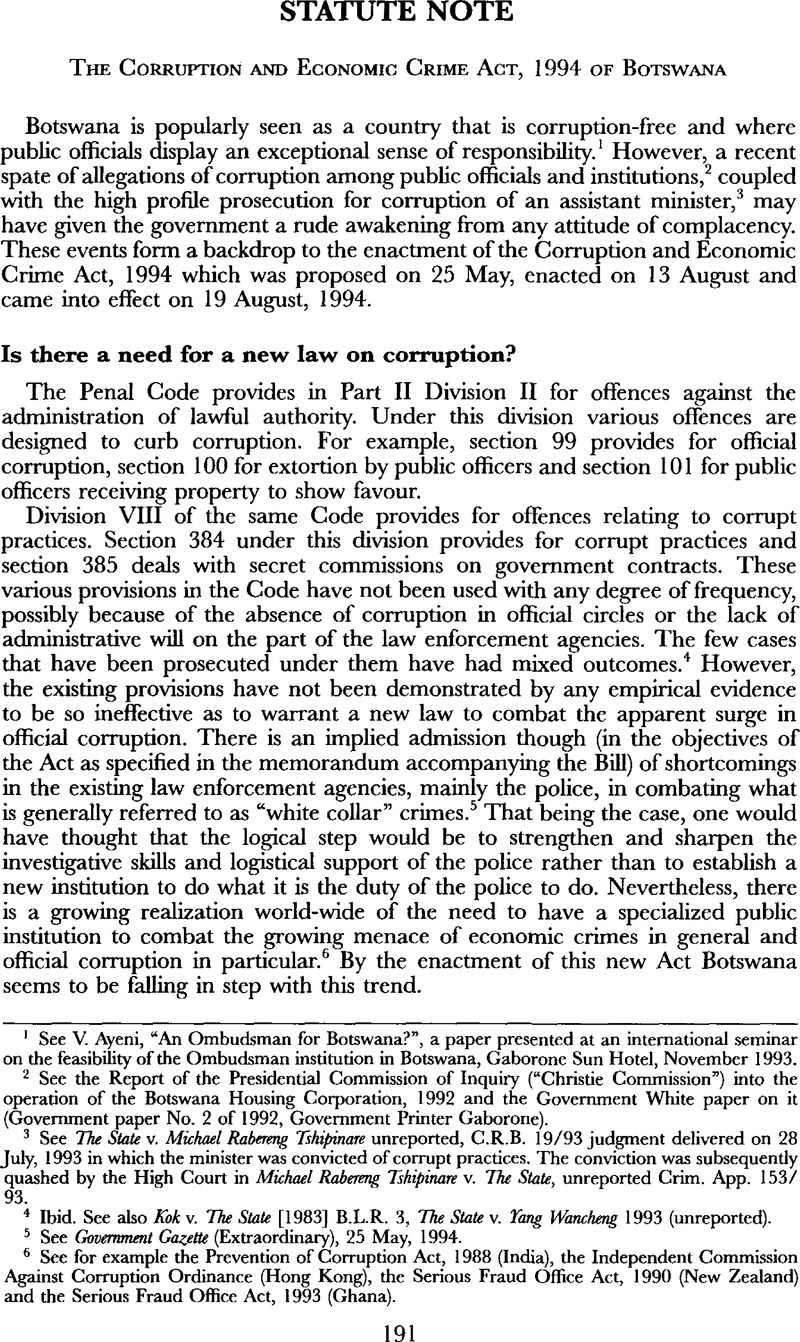Article contents
The Corruption and Economic Crime Act, 1994 of Botswana
Published online by Cambridge University Press: 28 July 2009
Abstract

- Type
- Statute Notes
- Information
- Copyright
- Copyright © School of Oriental and African Studies 1994
References
1 See Ayeni, V., “An Ombudsman for Botswana?”, a paper presented at an international seminar on the feasibility of the Ombudsman institution in Botswana, Gaborone Sun Hotel, November 1993.Google Scholar
2 See the Report of the Presidential Commission of Inquiry (“Christie Commission”) into the operation of the Botswana Housing Corporation, 1992 and the Government White paper on it (Government paper No. 2 of 1992, Government Printer Gaborone).
3 See The Slate v. Michael Rabereng Tshipinare unreported, C.R.B. 19/93 judgment delivered on 28 July, 1993 in which the minister was convicted of corrupt practices. The conviction was subsequently quashed by the High Court in Michael Rabereng Tshipinare v. The State, unreported Crim. App. 153/93.
4 ibid. See also Kok v. The State [1983] B.L.R. 3, The State v. Yang Wancheng 1993 (unreported).
5 See Government Gazette (Extraordinary), 25 May, 1994.
6 See for example the Prevention of Corruption Act, 1988 (India), the Independent Commission Against Corruption Ordinance (Hong Kong), the Serious Fraud Office Act, 1990 (New Zealand) and the Serious Fraud Office Act, 1993 (Ghana).
7 See ss. 99 and 385 of the Code.
8 See s. 6 of the Act.
9 S. 3.
10 In fact the Director was appointed long before the Bill was introduced in Parliament. See the editorial in Mmegi/Reporter, Vol. 11, No. 30 (29 July–4 August, 1994).
11 High Court judges can only be removed from office for inability to perform their functions due to infirmity of body or mind or from any other cause or for misbehaviour. See s. 97(2) of the Constitution. Despite this provision the practice of appointing expatriates on contract to the bench (and the Director of the Directorate is an expatriate) poses problems for the implementation of the constitutional provision. See Otlhogile, B., “Defamation by a judge: a note on Idah Ngope v. James Aiden O'Brien-Qumn”, (1991) Lesotho Law Journal, Vol. 7, No. 1, 107Google Scholar and “The history of the courts in Botswana”, unpublished Ph.D. thesis, 1990, Cambridge University.Google Scholar
12 The prosecution instituted against the assistant minister of Local Government and Lands (see n. 3 above) was with the consent of the Attorney-General. It would have been politically expedient to have refused consent but he did not. Further, at a recent press conference (12 September, 1994) the Director assured the nation that the Directorate would be acting with full operational independence, adding “By that I mean no one will be telling us who to investigate or not to investigate, no one will be telling us to stop investigation …”. See The Midweek Sun, 14 September, 1994 (front page).
13 See De Smith, , Constitutional and Administrative Law, (ed. Street, and Brazier, , 5th ed., Har-mondsworth, 1985)Google Scholar, 600 and Hood, Phillips, Constitutional and Administrative Law, (6th ed., London, 1976), 601.Google Scholar
14 In the early 1980s when the military government in Ghana interfered with such confidence more money was circulating outside the banking system than within it. This led to a serious dislocation of the banking system.
15 See A-G. v. Moagi [1982] (2) B.L.R. 124 in which the Court of Appeal held that giving due weight to the right not to testify at one's trial, the failure of the accused to testify may properly be considered by the court as a factor in determining his guilt.
16 See also s. 156(4) Companies Act 1959 (Cap. 42.01) which makes non-disclosure of such an interest a criminal offence with P200 fine.
17 See n. 3, above.
18 See s. 36.
19 S. 39.
20 See R. v. Baskenille [1916] 2 K.B. 685.Google Scholar
21 Sometimes it is difficult in such circumstances to determine whether the giver of the bribe is an accomplice or a victim. See the Nigerian case of Osidola v. Police (1958) N.R.N.L.R. 42.
22 The conviction of an accused on the sole evidence of any competent and credible witness is permitted by s. 239 of the Criminal Procedure and Evidence Act (Cap. 08.02). Will the giver of the bribe be such a witness?
23 See Andrew, and Hirst, , Criminal Evidence, (2nd ed., London, 1992), 110 and R. v. Carr-Briant [1943] K.B. 607.Google Scholar
24 See n. 3, above.
25 See p. 22 of the transcript of the judgment.
26 (1890) 25 Q.B.D. 494 (G.A.).
27 See Mmegi/The Reporter, Vol. 11, No. 30 (29 July–4 August, 1994), 5.Google Scholar
28 It is reported that five members out of the total of 34 MPs walked out in protest against the lack of good faith portrayed by their colleagues towards proposed amendments to the Bill. See Mrrugi/The Reporter, above, 4.
29 See n. 12, above.
- 3
- Cited by




